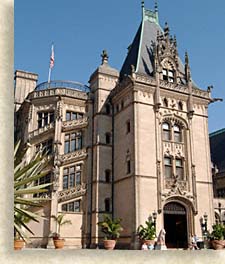 Mrs.
Highlander and I visited the Biltmore House several times; each
time the experience was different due to the exterior daylight. A
bright day yields strong interior light an overcast day creates
’re both equally intriguing.
Mrs.
Highlander and I visited the Biltmore House several times; each
time the experience was different due to the exterior daylight. A
bright day yields strong interior light an overcast day creates
’re both equally intriguing.
We crossed the threshold of Biltmore House and enter the Entrance
Hall to take in the sights and the sound of echoes past. We
become immersed in the stone arches crowned with a wood vaulted
ceiling as we heard to the faded clicks of heels on polished marble
floors. Although this was a private home, you immediately sense
the feel of a grand museum, a structure meant to house works of
art and state of the art late 19th century technology.
Facing inward I sense the vision of two men unfolding, the collaboration of George Vanderbilt and Richard Hunt’s vision of the interior of Biltmore House begins here.
The great hall was dark, and a bit eerie, imposing,
yet not intimidating. Looking  thru
the dim light, your eyes are soon attracted to rays of sunlight
showing thru the arches to the right. Light fell in abundance from
ceiling to floor, thru the neighboring room.
thru
the dim light, your eyes are soon attracted to rays of sunlight
showing thru the arches to the right. Light fell in abundance from
ceiling to floor, thru the neighboring room.
To the left, another shower of sunlight flows gently down a spiral marble staircase like a silky veil of light cascading over a waterfall.
The arches in the Entrance Hall open to various rooms as though you’re standing at the center of a labyrinth choosing a way out. The preferable way to venture beyond the hall is right in your hand, the handy self guided tour provided by the staff at Biltmore House, a treasure map that will lead you from start to finish, a detailed program of what lies ahead on your journey.
Also available at Biltmore House are guided audio tour tapes with headsets as well as guided group tours to restricted areas of the house. At the estate's gift shops you can find a coffee table book titled “A Guide to Biltmore Estate,” an in-depth history of the estate and house which is available for purchase.
Our first steps on the tour take us to one of our three favorite rooms, the Winter Garden. Spectacular barely describes it, sunken from the main floor, open, with a roof made of architecturally sculptured wood and glass. A stylish interior garden, popular during the Victorian Age, exceptional by any comparison, a marvel in its self.
With each visit to the Biltmore House we discover a different theme in its decoration. Normally the Winter Garden is more serene, less formal, the rounded table setting depicted here is reminiscent of Cornelia Vanderbilt and John Cecil’s wedding breakfast in 1924, an anniversary theme that is carried throughout the house as a remembrance of her wedding celebration at Biltmore House.
What you will always find in the Winter Garden is its centerpiece artwork, a marble and bronze fountain sculpture “Boy Stealing Geese” by Viennese artist Karl Bitter. This is one of the many pieces within George W. Vanderbilt’s original collection.
The garden room is round, lined with stone archways; a grand hallway leads the full circle of the room allowing visibility to the garden from any direction.
 Our
next encounter brings us to the Billiard Room, part of Biltmore
House’s Bachelor's Wing. Decorated with an ornamental plaster
ceiling and rich oak paneling the Billiard Room was equipped with
both a pool table and a carom table (table without pockets.) This
room was mostly an attraction to manly men, yet welcoming the ladies
if they chose to stop by. Secret door panels on either side
of the fireplace lead to the private quarters of the Bachelors’
Wing.
Our
next encounter brings us to the Billiard Room, part of Biltmore
House’s Bachelor's Wing. Decorated with an ornamental plaster
ceiling and rich oak paneling the Billiard Room was equipped with
both a pool table and a carom table (table without pockets.) This
room was mostly an attraction to manly men, yet welcoming the ladies
if they chose to stop by. Secret door panels on either side
of the fireplace lead to the private quarters of the Bachelors’
Wing.
The Bachelor Wing included the Smoking Room and Gun Room. Female staff members weren’t allowed in the Bachelor's Wing for the obvious reason, boys will be boys.
The Smoking Room was an all male gathering parlor, fashionable for country houses, here men chomped on cigars, smoked pipes and puffed on cigarettes. They likely sipped brandy and either talked business or read from its library of books.
The Gun Room held mounted trophies and once displayed George Vanderbilt’s gun collection.
Biltmore Estate was perfect for outdoor sporting recreation such as hunting, fishing, hiking, and equestrian activities. What better place to enjoy the outdoors than the heart of the Blue Ridge Mountains.
We now move from the personal confines of masculinity and enter the grand expanse of male ingenuity, power and excellence...the Banquet Hall. Here you can imagine the fabled kingdom of Camelot, earlier we passed a resemblance of King Arthur’s round table in the Winter Garden and now we stand humbled in the presence of the royal court.
The Banquet Hall measures 72 feet long, 42 feet wide with a 70 foot high barrel vaulted ceiling. This is one of the three grandest rooms in the house, any work of art is pale in comparison to the architectural art within the Banquet Hall. Hunt also designed the furnishing, an oak dining table with 64 chairs and two throne chairs in gilt trim. There are five Flemish tapestries dating between 1546 and 1553. A triple fireplace is at the opposite end of the hall supporting an over the mantel, high relief panel entitled “The Return from the Chase” carved by artist Bitter.
Bitter also created the oak mural on the organ gallery at the opposite end of the hall. Large arched windows divide the stoned walls, from the barrel-vaulted ceiling. Lining the upper hall are trophy heads, stone sculptures of knights and wall carvings.
Below the organ gallery is a built-in sideboard displaying a collection of 18th and 19th century brass and copper vessels, I didn’t see the Holy Grail there, they must have put it away for safe keeping.
The Banquet Hall was a favored room during the Christmas Holidays when George and Edith Vanderbilt would entertain their guest and the large staff of employees. They filled the hall with a Christmas tree that stretched from floor to ceiling. They handed out gifts showing their appreciation to those who helped maintain and preserve their dream existence. Even today the Biltmore House holds a private holiday celebration for its entire staff, in remembrance of the fondness the Vanderbilt's had for this special occasion.
 Leaving
the Banquet Hall and the adventures of King Arthur behind we move
on to the next room where we find ourselves in the tranquil and
intimate setting of the Breakfast Room. I can’t imagine
the Vanderbilt's taking breakfast or any of their three daily meals
in the Banquet Hall, a little too much to digest without the company
of lets say, several dozen people. The Breakfast Room is
warm and elegant; I can just imagine the fine delicacies served
here on exquisite china, embroidered linens and using crystal glasses
etched with the Vanderbilt Monogram. Family portraits of
Cornelius, William Henry and Maria Louisa surround the room, inspiring
George and his immediate family during each meal. The centerpiece
on the table is part of the wedding theme of daughter Cornelia
Vanderbilt Cecil.
Leaving
the Banquet Hall and the adventures of King Arthur behind we move
on to the next room where we find ourselves in the tranquil and
intimate setting of the Breakfast Room. I can’t imagine
the Vanderbilt's taking breakfast or any of their three daily meals
in the Banquet Hall, a little too much to digest without the company
of lets say, several dozen people. The Breakfast Room is
warm and elegant; I can just imagine the fine delicacies served
here on exquisite china, embroidered linens and using crystal glasses
etched with the Vanderbilt Monogram. Family portraits of
Cornelius, William Henry and Maria Louisa surround the room, inspiring
George and his immediate family during each meal. The centerpiece
on the table is part of the wedding theme of daughter Cornelia
Vanderbilt Cecil.
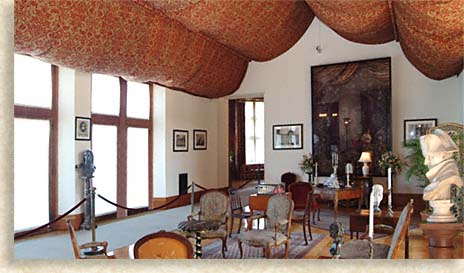 From
the Breakfast Room we enter the adjacent Salon. The bellowing fabric
hanging from the ceiling presents the feeling of an indoor canopy,
expressing the Victorian appreciation of Oriental and Moorish styles.
The adjoining balconies cast light into the room, this was a favorite
room for guests. The Louis XV style seating was perfect for conversing
as well as game playing. A most notable piece of history in the
room is one of George Vanderbilt’s personal favorites, an
Empire walnut game table with ivory chess pieces, once owned by
Napoleon Bonaparte. Playing a game at this board had to be
a thrill for some of George’s special guests.
From
the Breakfast Room we enter the adjacent Salon. The bellowing fabric
hanging from the ceiling presents the feeling of an indoor canopy,
expressing the Victorian appreciation of Oriental and Moorish styles.
The adjoining balconies cast light into the room, this was a favorite
room for guests. The Louis XV style seating was perfect for conversing
as well as game playing. A most notable piece of history in the
room is one of George Vanderbilt’s personal favorites, an
Empire walnut game table with ivory chess pieces, once owned by
Napoleon Bonaparte. Playing a game at this board had to be
a thrill for some of George’s special guests.
Our Highlander tour now takes us to the Music
Room. This room had been set aside as a music room but unfinished
for 81 years. George 's sensibly
planned a space for the musical arts, but left it for his children
to complete. The Music Room was opened in 1976, decorated in the
French Renaissance style with red oak carved wall paneling, harvested
from the Biltmore forest.
's sensibly
planned a space for the musical arts, but left it for his children
to complete. The Music Room was opened in 1976, decorated in the
French Renaissance style with red oak carved wall paneling, harvested
from the Biltmore forest.
Even though it was considered the Gay 90’s, I can’t imagine George getting all pumped up and heading over to the music room to belt out a few of the latest and more popular tunes of the day. George Vanderbilt was considered a quiet man with a passion for reading.
The Music Room is graced with a rare collection of the 12 apostles a figurine set produced in the mid 1700’s by the Meissen porcelain factory. The soul of the room hovers around the Steinway piano.
As we enter the Tapestry Gallery, we look down a 90 ft long hall that served as a sitting room and an occasional ballroom. The gallery displayed three large tapestries known as “The Triumph of the Seven Virtues;” the original works included 7 tapestries depicting biblical, mythological and historical images. 19th century Persian carpets cover the floors of the seating areas in the Tapestry Gallery, just a few examples of the hundreds of Eastern carpets purchased by Mr. Vanderbilt.
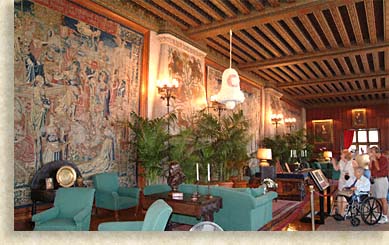 |
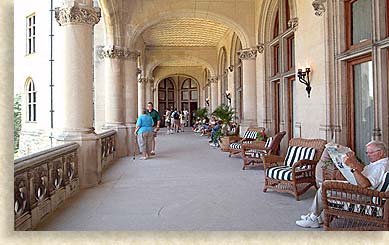 |
Two fireplaces line the inner wall with paintings above the mantels depicting a Medieval boar and stag hunt. The white bell hung from the ceiling is part of anniversary celebration of Cornelia’s wedding at Biltmore House. Across the room from the tapestries is a wall of arched doorways leading out onto the Loggia Terrace; the glass door panels drew light onto the tapestry’s intricate scenes.
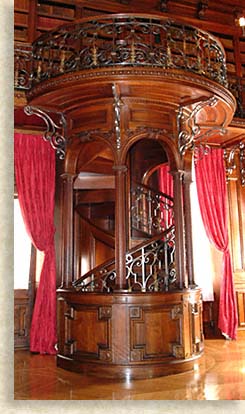 At
the end of the gallery you’ll find George Vanderbilt’s
favorite room and one of the most featured rooms in photographs…the
Library, used often to depict the heart of the Biltmore House.
At
the end of the gallery you’ll find George Vanderbilt’s
favorite room and one of the most featured rooms in photographs…the
Library, used often to depict the heart of the Biltmore House.
This room reflects George’s true passion, the art of the written word. George began collecting books before he was 11 years old, amassing a collection of 23,000 volumes on various subjects.
The ornate woodworking in this room is mesmerizing. There are 10,000 books in eight languages, filling the Library’s walnut shelves. A hidden passage behind the mantel leads to the second floor guest quarters as a convenience for late night readers.
The walnut overmantel above the black marble fireplace was carved by artist Karl Bitter.
The walls are lined with two story's of stacked bookshelves. The second floor balcony is reachable by an ornately tooled walnut spiral staircase offering a dramatic overview of the library below. As I stood on the balcony looking up, I felt a little closer to heaven, the ceiling itself was an extraordinary work of art, "The Chariot of Aurora", by Venetian artist Giovanni Antonio Pellegrini (1675-1741).
This art was originally located in the ballroom of the Pisani Palace in Venice. Thirteen separate canvases measuring a total of 64 ft long by 32 ft wide. This artwork creates a feeling of the open sky with angels welcoming the dawn. The Library has a grand presence, yet to me it was the coziest room in Biltmore House and one of my favorite three rooms. If you’re looking to get a feel for George’s spirit, I believe this room accentuates his true self.
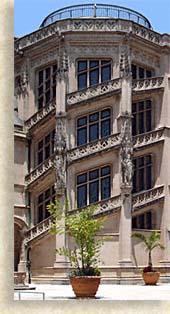
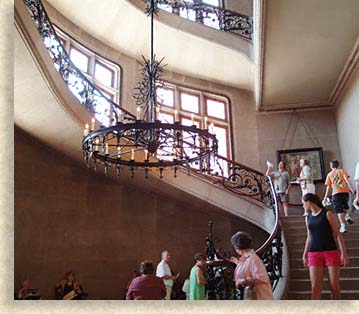 These
nine lavish and opulent rooms are the public rooms on the first
floor of the Biltmore House where George and Edith entertained
in a style few could compare.
These
nine lavish and opulent rooms are the public rooms on the first
floor of the Biltmore House where George and Edith entertained
in a style few could compare.
Now we come to the Grand Staircase with its four-story iron chandelier illuminated by 72 electric bulbs. When photographing the staircase you have to dissect it in pieces or shoot straight up the stairwell thru the chandelier along the elevated polished marble staircase.
The best way to depict this engineering wonder is to show the outer tower enclosure. The towering stairway within a 16th century French castle was the inspiration for George Vanderbilt’s Grand Staircase, the difference being the way they spiraled. Armored clad sentries of stone grace the outer walls of the Grand Stairway, offering safe passage to the tower travelers.
 Ascending
the staircase you find yourself in the Second Floor Living Hall. This
less
Ascending
the staircase you find yourself in the Second Floor Living Hall. This
less  formal
atmosphere was a gathering place for family and guests. The
hall is spacious with several sitting areas. The outer walls of
the hall support large painted portraits. At one end of the Hall
the Vanderbilt family portrait shows George at the age of eleven. On
the other end of the hall is a portrait of the William Cecil family.
The outer wall displays individual portraits of Richard Morris
Hunt and Frederick Law Olmsted along with a portrait of Cornelia
Vanderbilt Cecil.
formal
atmosphere was a gathering place for family and guests. The
hall is spacious with several sitting areas. The outer walls of
the hall support large painted portraits. At one end of the Hall
the Vanderbilt family portrait shows George at the age of eleven. On
the other end of the hall is a portrait of the William Cecil family.
The outer wall displays individual portraits of Richard Morris
Hunt and Frederick Law Olmsted along with a portrait of Cornelia
Vanderbilt Cecil.
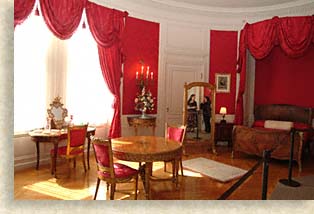 Doorways
at the end of the Living Hall on either side of the Cecil family
portrait lead into a guest room for very special occupants. The
Louis XVI Room is a lavishly decorated oval shaped room, a style
made popular during the 18th century reign of King of France Louis
XVI. The room is isolated from all other guest; I can only imagine
the VIP’s that have slept there.
Doorways
at the end of the Living Hall on either side of the Cecil family
portrait lead into a guest room for very special occupants. The
Louis XVI Room is a lavishly decorated oval shaped room, a style
made popular during the 18th century reign of King of France Louis
XVI. The room is isolated from all other guest; I can only imagine
the VIP’s that have slept there.
Leaving the Louis XVI Room, we reenter the Second Floor Living Hall, to the west of the hall are three other luxury guest rooms in a separate wing with prestigious titles such as the Chippendale Room, The Old English Room and The Sheraton Room.
We continue across the Living Hall to the private living quarters of George and Edith Vanderbilt.
 George
Washington Vanderbilt’s Bedroom is literally fit for a king,
both in luxury and solitude. No greater place in Biltmore
House displays George’s sense of being than here in the master's
quarters. The room has the feel of the master; the 17th century
Portuguese walnut furnishings are strong and sure, commanding,
yet elegant.
George
Washington Vanderbilt’s Bedroom is literally fit for a king,
both in luxury and solitude. No greater place in Biltmore
House displays George’s sense of being than here in the master's
quarters. The room has the feel of the master; the 17th century
Portuguese walnut furnishings are strong and sure, commanding,
yet elegant.
The royal bath contains a round marble tub fully equipped with hot and cold running water. Keep in mind the house was built during a time when horsepower often meant just that…“horse” power. Some of the conveniences that we take for granted today were only available to the affluent in the late 19th century.
George’s bedroom is in one of two towers on the back of the Biltmore House. From his post in the tower bedroom George could survey a portion of his mountain kingdom, Mount Pisgah stands towering on the horizon, 17 miles away.
Moving from the Master Bedroom, we enter the private sitting room used exclusively by George and Edith. The Oak Sitting Room reflects every element of quality. The rich warm wood of high panel walls capped by an ornate plaster ceiling is the most awe-striking feature of the large sitting room.
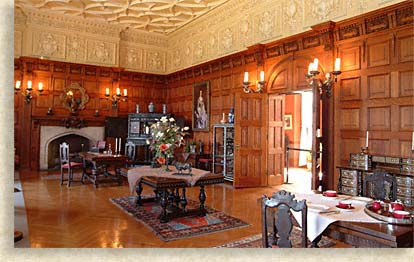 |
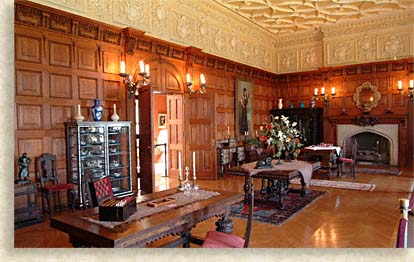 |
Twin fireplaces occupy each end of the room with three sculptured leg tables down the center. In the corner is an ornately carved ebony cabinet on a stand with a miniature scene displayed. This was a perfect hideaway for George and Edith, I can see George sneaking down the secret passageway to the Library selecting a novel and slipping back upstairs, cuddling up by the fireplace in the warmth and privacy of in his own personal space.
Mrs. Vanderbilt’s Bedroom, at the opposite end of the Oak Sitting Room, is located in the second tower on the backside of Biltmore House. Edith’s bedroom is striking, in colors of gold and purple fabrics and furnishings. The oval shape of the room accents the feminine, while George’s bedroom is angular and strong.

When George first finished the house he was still a bachelor, his mother Maria Louisa Kissam Vanderbilt stayed in the room during her visits before George and Edith were married. Edith’s private chambers are nothing less than a royal boudoir for a grand lady.
There’s also a third floor of guestrooms with dignified titles as well as another sitting hall, we’ll leave that to your personal discovery when you visit Biltmore House.
Back at the Grand Staircase, we descend to the hub of activity that keeps this luxury liner afloat, the lower level. Even when it was quiet upstairs, the lower level was hustling and bustling. If the Biltmore House were the Queen Mary, the lower level is where you would find the engine that drove her.
Checking my handy guide, I count over 30 work related rooms on the lower level. Rather than take you on a room by room tour, I'm just going to give you a list of some of the rooms you’ll find below deck and for a special treat we’ll run a slide show to your right.
Main Kitchen • Rotisserie Kitchen • Pastry Kitchen • Kitchen Pantry • Vegetable Pantry • Canning Pantry • Walk In Refrigerator • Small Pantry • 2 Floral Work Rooms • Housekeeper’s Pantry • Brown Laundry • Main Dying Room • Laundresses Toilet • Organ Motor Room • 7 Servants’ Bedrooms • Servants’ Dining Room & Servants’ Sitting Room.
This was a world unto itself, crafts people and chefs, housekeeper and handymen, personal assistants, butlers, servers and staff mangers to name a few. The basement quarters were immaculate yet modestly decorated.
It was vital to Edith and George that their staff be formally trained in their particular skill whether they stayed on at Biltmore House or sought employment elsewhere. The Vanderbilt’s commitment to helping others is what led them to found the School for Domestic Science, training young women in the service industry. They also started Biltmore Estate Industries as an apprenticeship program teaching traditional crafts in woodworking and weaving.
As we follow thru the tunnel stonewall corridors; it seems, as though we’re moving thru the catacombs of a Medieval castle. A section of the lower level, roughly equal to the size to the staff's entire work area was set-aside for guest activities at Biltmore House.
 |
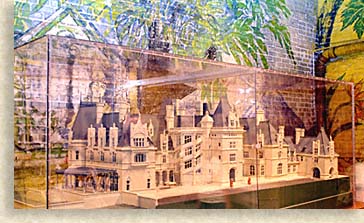 |
We arrive at the far end of the lower level below one of the Biltmore House’s outer wings. We enter an enormous stonewalled room, known as the Halloween Room. The room took its name courtesy of one of Cornelia Vanderbilt Cecil's parties. The guests painted various scenes on the walls during a 1920’s party (better known as the roaring 20's). These painting remain there today. The room is now used as an exhibit hall depicting the story of the construction days of the Biltmore Estate in the late 1800’s. There’s a large glass enclosed model of the Biltmore House, allowing a bird's eye view of the house.
Other sections of the lower level were setup for fun and recreation with a 19th century “state of the art” Gymnasium, a 53’ x 27’, 8.5 ft deep swimming pool, and at least 9 adjacent changing rooms. The dressing rooms were used for both indoor and outdoor activities, "wouldn’t want to mess up the house."
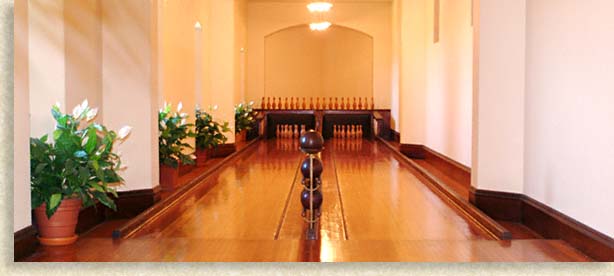
The crème de la crème of our tour of the lower level is the Bowling Alley. The Dutch brought the pastime of bowling to America in the 1600’s. Biltmore House installed a double lane alley in 1895. It is one of the oldest bowling alleys in the nation and Brunswick was there to provide the necessary equipment.
We exit from below the deck and go topside passing thru the Bachelor's Wing and leave the confines of the magnificent Biltmore House behind.

Click to enter the Stable Courtyard at Biltmore Estate...
![]()
Sign
up for the Blue Ridge Highlander Newsletter, Messages from the Mountains
to find out first about our new feature stories, road trips and special offers
Your e-mail addresses will not be sold or given away to anyone.
Privacy
Policy
Interested in your business being on the Highlander, click here...
Let our visitors tell you about the Highlander...
Click the feathers to go to the Highlander site
map...


